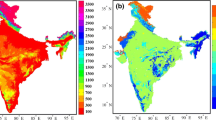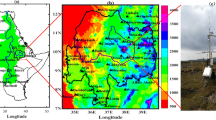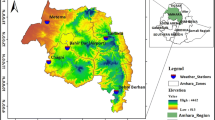Abstract
This paper analyzes seasonal and diurnal variations of MODerate resolution Imaging Spectroradiometer (MODIS) land surface temperature (LST) data at ~1.1 km for the period of 2003–2011 over a region in West-Central Texas, where four of the world’s largest wind farms are located. Seasonal anomalies are created from MODIS Terra (~10:30 a.m. and 10:30 p.m. local solar time) and Aqua (~1:30 a.m. and 1:30 p.m. local solar time) LSTs, and their spatiotemporal variability is analyzed by comparing the LST changes between wind farm pixels (WFPs) and nearby non wind farm pixels (NNWFPs) using different methods under different quality controls. Our analyses show consistently that there is a warming effect of 0.31–0.70 °C at nighttime for the nine-year period during which data was collected over WFPs relative to NNWFPs, in all seasons for both Terra and Aqua measurements, while the changes at daytime are much noisier. The nighttime warming effect is much larger in summer than winter and at ~10:30 p.m. than ~1:30 a.m. and hence the largest warming effect is observed at ~10:30 p.m. in summer. The spatial pattern and magnitude of this warming effect couple very well with the geographic distribution of wind turbines and such coupling is stronger at nighttime than daytime and in summer than winter. Together, these results suggest that the warming effect observed in MODIS over wind farms are very likely attributable to the development of wind farms. This inference is consistent with the increasing number of operational wind turbines with time during the study period, the diurnal and seasonal variations in the frequency of wind speed and direction distribution, and the changes in near-surface atmospheric boundary layer (ABL) conditions due to wind farm operations. The nocturnal ABL is typically stable and much thinner than the daytime ABL and hence the turbine enhanced vertical mixing produces a stronger nighttime effect. The stronger wind speed and the higher frequency of the wind speed within the optimal power generation range in summer than winter and at nighttime than daytime likely drives wind turbines to generate more electricity and turbulence and consequently results in the strongest warming effect at nighttime in summer. Similarly, the stronger wind speed and the higher frequency of optimal wind speed at ~10:30 p.m. than that at ~1:30 a.m. might help explain, to some extent, why the nighttime LST warming effect is slightly larger at ~10:30 p.m. than ~1:30 a.m. The nighttime warming effect seen in spring and fall are smaller than that in summer and can be explained similarly.










Similar content being viewed by others
References
Adams AS, Keith DW (2007) Wind energy and climate: modeling the atmospheric impacts of wind energy turbines. EOS Trans AGU 88 (Fall Meeting Suppl.), abstr. B44B-08
AWEA (2011) U.S. Wind Energy Market Update, American Wind Energy Association. (http://www.awea.org/learnabout/publications/factsheets/upload/Market-Update-Factsheet-Final_April-2011.pdf)
AWEA (2012) AWEA 4th Quarter 2011 Public Market Report, American Wind Energy Association. (http://awea.org/learnabout/publications/reports/upload/4Q-2011-AWEA-Public-Market-Report_1-31.pdf)
Baidya Roy S (2011) Simulating impacts of wind farms on local hydrometeorology. J Wind Eng Ind Aerodyn. doi:10.1016/j.jweia.2010.12.013
Baidya Roy S, Traiteur JJ (2010) Impacts of wind farms on surface air temperatures. Proc Natl Acad Sci USA 107:17899–17904
Baidya Roy S, Pacala SW, Walko RL (2004) Can large scale wind farms affect local meteorology? J Geophys Res 109:D19101
Barrie D, Kirk-Davidoff D (2010) Weather response to management of large wind turbine array. Atmos Chem Phys 10:769–775
Combs S (2008a) The Energy Report 2008, Texas controller of public accounts. (http://www.window.state.tx.us/specialrpt/energy/)
Combs S (2008b) Texas renewable energy resource assessment, Texas controller of public accounts. (http://www.seco.cpa.state.tx.us/publications/renewenergy/)
Eastman JL, Coughenour MB, Pielke RA (2001) The effects of CO2 and landscape change using a coupled plant and meteorological model. Glob Change Biol 7:797–815
Fiedler BH, Bukovsky MS (2011) The effect of a giant wind farm on precipitation in a regional climate model. Environ Res Lett 6. doi:10.1088/1748-9326/6/4/045101
Gallo KP, Owen TK (1997) Satellite-based adjustments for the urban heat island temperature bias. J Appl Meteorol 36:1117–1132
Hylton H (2011) Forget irene: the drought in Texas is the catastrophe that could really hurt, Time U.S., 31 Aug 2011. (http://www.time.com/time/nation/article/0,8599,2091192,00.html)
Keith D, DeCarolis J, Denkenberger D, Lenschow D, Malyshev S, Pacala S, Rasch PJ (2004) The influence of large-scale wind power on global climate. Proc Natl Acad Sci USA 101:16115–16120
Kirk-Davidoff DB, Keith DW (2008) On the climate impact of surface roughness anomalies. J Atmos Sci 65:2215–2234
Knippertz P, Ulbrich U, Speth P (2000) Changing cyclones and surface wind speeds over the North Atlantic and Europe in a transient GHG experiment. Clim Res 15:109–122
Kumar V, Svensson G, Holtslag AA, Meneveau C, Parlange MB (2010) Impact of surface flux formulations and geostrophic forcing on large eddy simulations of diurnal atmospheric boundary layer flow. J Appl Meteorol Climatol 49:1496–1516
McNider RT, Lapenta WM, Biazar A, Jedlovec G, Suggs R, Pleim J (2005) Retrieval of gridscale heat capacity using geostationary satellite products: part I: case-study application. J Appl Meteorol 88:1346–1360
Peterson TC (2003) Assessment of urban versus rural in situ surface temperatures in the contiguous United States: no difference found. J Clim 16(18):2941–2959
Pielke RA Sr, Matsui T (2005) Should light wind and windy nights have the same temperature trends at individual levels even if the boundary layer averaged heat content change is the same? Geophys Res Lett 32:L21813. doi:10.1029/2005GL024407
Rienecker M et al (2011) MERRA: NASA’s modern-era retrospective analysis for research and applications. J Clim 24:3624–3648
Simmonds I, Keay K (2002) Surface fluxes of momentum and mechanical energy over the North Pacific and North Atlantic Oceans. Meteorol Atmos Phys 80:1–18
Sta Maria MRV, Jacobson MZ (2009) Investigating the effect of large wind farms on energy in the atmosphere. Energies 2(4):816–838
Stull RB (2009) An introduction to boundary layer meteorology. Springer, Berlin, pp 9–19
USDOE (2008) 20 % Wind by 2030, U.S. Department of Energy. (http://www1.eere.energy.gov/wind/pdfs/42864.pdf)
USDOE (2011) Strengthening America’s energy security with offshore wind. U.S. Department of Energy. February 2011. (www.nrel.gov/docs/fy11osti/49222.pdf)
Wan Z (2002) Estimate of noise and systematic error in early thermal infrared data of the Moderate Resolution Imaging Spectroradiometer (MODIS). Remote Sens Environ 80:47–54
Wan Z (2006) New refinements and validation of the MODIS land surface temperature/emissivity products. Remote Sens Environ 112:59–74
Wang C, Prinn RJ (2010) Potential climatic impacts and reliability of very large-scale wind farms. Atmos Chem Phys 10:2053–2061
Wigley TML, Santer BD (2012) A probabilistic quantification of the anthropogenic component of 20th century global warming, Clim Dyn (in press)
Zhou L, Tian Y, Baidya Roy S, Thorncroft C, Bosart LF, Hu Y (2012) Impacts of wind farms on land surface temperature. Nat Clim Chang 2(7):539–543
Acknowledgments
This study was supported by the startup funds provided by University at Albany, SUNY and by National Science Foundation (NSF AGS-1247137). H. Chen was supported by the National Basic Research Program of China (Grant No. 2011CB952000). Y. Dai was supported by the National Natural Science Foundation of China under grant 40875062 and the 111 Project of Ministry of Education and State Administration for Foreign Experts Affairs of China. The MERRA reanalysis data is obtained from the NASA/GSFC/GMAO data server. Chad Eilering and Maxwell Smith helped generate the Google Earth kml files.
Author information
Authors and Affiliations
Corresponding author
Rights and permissions
About this article
Cite this article
Zhou, L., Tian, Y., Baidya Roy, S. et al. Diurnal and seasonal variations of wind farm impacts on land surface temperature over western Texas. Clim Dyn 41, 307–326 (2013). https://doi.org/10.1007/s00382-012-1485-y
Received:
Accepted:
Published:
Issue Date:
DOI: https://doi.org/10.1007/s00382-012-1485-y




